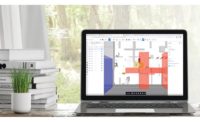The rapidly evolving software segment for the MEP industry continues to broaden the scope of engineers’ designs.
“Projects can now be designed at a building level rather than floor-to-floor,” says Ralph Schoch, the Revit, technology and internal support manager with Easton, Pennsylvania-headquartered Victaulic. “This brings more data into the model and creates a tool for every project stakeholder.”
More data to decipher means programs such as Victaulic’s recently enhanced “2019 Tools for Revit” platform can do more to streamline an engineer’s design and project construction.
“This data is powerful; Revit models not only can assist with creating accurate estimates, but they also can tell you whether a project will be completed on time, if a building will run efficiently and how to get back on track if a project is delayed,” Schoch adds. “This access to data makes technology an integral part of the construction process and companies that embrace technology are quickly seeing the benefits to their bottom line.”
Schoch believes coordination will be critical since the level of detail within each Revit model is improving and the technology is becoming more prevalent in the industry.
“Software is having an enormous impact on the plumbing and larger MEP community,” he says. “As Revit has become more commonplace within the industry companies are seeing enhanced levels of coordination, and as a result the level of detail within each model is improving.
“Technology is advancing at such a rapid pace, companies need to work to keep up with the changes. This involves training teams and implementing new hardware and software.”
James Reis, Trimble’s business area director, notes software for the MEP industry must make an engineer’s daily duties a little easier.
“If there’s a buzzword, it’s workflow,” he says. “We are focused on specific workflows — designing a mechanical system in a proper workflow. We are vertically-focused.”
Providing tools also is of critical importance for engineers to do their jobs, Reis adds.
“We are finding that engineering firms are looking for more tools in the Revit platform,” he states, “specifically in how to detail their models. The industry is asking for more content on how systems are designed and installed.”
Giving them what they want
Last month, Zurn launched its latest major development with inSpec — an online project specifier and manager. Available on www.zurn.com, inSpec is a tool that provides “a relentless tool for solving problems for our customers and making things easier” for them, Zurn’s Director of Digital Marketing and Communications David Krohn explains.
“The theme of this platform is simplicity and time-savings,” he notes. “That’s what we’re hoping to accomplish as we get adoption among specifiers.”
inSpec allows engineers and designers to sign up for an account, create unlimited projects and quickly begin selecting from Zurn’s advanced water solutions and parts. (Note: Zurn trench drains currently cannot be selected on inSpec, but are expected to be available in late 2018).
“For our finish plumbing product configurations, the first thing a plumbing engineer will see is our product recommendations,” Krohn says. “We’ve provided prepackaged options inSpec users can add to their projects.
“But, as we know, engineers aren’t always going to gravitate toward what we give them, so we also developed a custom configuration process. This puts our portfolio of products at their fingertips to mix and match — everything is in one place and completely compatible.”
For Zurn’s line of drains and water-safety and control products, the system provides a guided configuration process. Users answer a series of questions about the product they are seeking.
“While they are answering the questions, inSpec puts together a recommended solution with the fully-configured part number ready to go,” Krohn says.
Additionally, users can copy as many elements from a project to a new or existing project within their account on the platform. They can share the project with anyone within their firm. The colleague then has access to make changes to the specifications, if needed.
“The copy function was something engineers said they really wanted,” Krohn says. “We offer as much flexibility as possible without sacrificing security. inSpec lets users copy an entire project or select just a single configuration.”
The inSpec platform was “aggressively, yet thoughtfully developed” over the last eight months, based on the feedback gathered from about 25 engineering firms, Krohn states.
“A traditional development cycle for a tool like this would be 12 to 18 months,” he adds. “Our product, engineering, digital and development teams rallied together to accelerate the schedule. A lot of testing has gone into the platform because we know engineers don’t have patience for things being wrong.”
Revit takes hold
Apple Valley, Minnesota-based PEX manufacturer Uponor has made software and technology advancements a key priority in recent years. Stephanie Radel, a design services supervisor at Uponor, notes the company provides a full library of BIM content files at www.uponorengineering.com. Radel leads the potable-water team at Uponor and also has seen a major spike in the use of Revit in the MEP community after working with AutoCAD for years.
“We’re hoping to switch fully to Revit in the near future,” she says. “We’re working on our templates and using the content we post online for development. This helps pinpoint some of those pain points MEP engineers and contractors have with content in general.”
Lee Browning, a supervisor of Uponor’s estimation services, has been in the industry for 12 years and has witnessed the late 2000s boom of Revit.
“Around 2010, 2012 is when the MEP portion of Revit became usable and worked well for MEP engineers,” he notes. “Revit has been the main software they’ve been going to, it’s the way to go.”
Radel adds: “People really saw the benefit of working within Revit. Once engineers put the work in to get things set up for how Revit could work within their workflows, they’re really seeing the efficiencies and more capabilities from it. That’s why we’re seeing the jump in use happen a little faster than we were initially expecting.”
Browning sees the long road ahead for software in the industry and the payoff at the end of the line is one program that can do everything. He knows that will take time.
“We’re always trying to use one software to do it all. We’re trying to get to that finish line where one software can design, fabricate, etc.,” Browning says. “That’ll be a big push. Trying to streamline and get a standard in the industry — it’ll be a tough process.”
Taking the right route
Schoch notes the 2019 Victaulic Tools for Revit enhancement was developed to improve routing efficiencies for the MEP community.
“The 2019 version of the toolbar brings a multitude of new shortcuts and tools allowing engineers to save time by reducing clicks and corrections,” he states. “Notably, the new Leveler tool gives engineers the ability to place their entire piping system on the correct level of a model, mitigating the risk of items being incorrectly associated within the design.”
Schoch also highlights the program’s Any Connect Tool that can connect systems in any view with one click of the mouse. He says routers “no longer have to fight with the model to get a pump to connect with a suction diffuser.”
These toolbar enhancements were able to be available because Schoch and Victaulic worked with engineers before and during the development of 2019 Victaulic Tools for Revit.
“We constantly interface with Revit users through contact forms on our website as well as with engineers during customer presentations, and training and implementation sessions,” he states. “What we have learned through these findings is every company has a unique workflow. As we develop our toolbar enhancements we listen to their needs, recognize their struggles and create tools that can be utilized by almost every user. Also, every tool is tested internally before it is released to the larger MEP community, ensuring our customers receive reliable and dependable software.”
A clear vision
Schoch foresees the future of software and the MEP industry will be the way “we initiate and visualize a project.”
“As scanning technology such as the FARO come down in price, and the HTC VIVE virtual reality lens and Microsoft HoloLens improve, they will be more heavily adopted within the industry,” he says. “Couple that with software like Autodesk ReCap Pro which converts a scan into a solid object mesh and projects can now be initiated with a scan, cleanly imported into Revit, and quickly visualized through systems like 3DS Max and virtual reality lenses. This convergence of software and hardware is truly streamlining projects and will be the next technology trend to drive the industry forward.”
Reis believes engineers can use software to take advantage of and improve on ROI. “If you model with a higher level of content, the designs are better and they convey better information to contractors,” he says.
Reis and Trimble see how building owners are becoming more involved with design and they want to see the digital models from engineers, not just a PDF printout.
“They’re becoming more thoughtful. They’re giving owners more information in the models,” he says. “We’re seeing more firms delivering a more coordinated effort. That’s been a big change. The level of detail has increased and that’s because of pressure from peers.”







